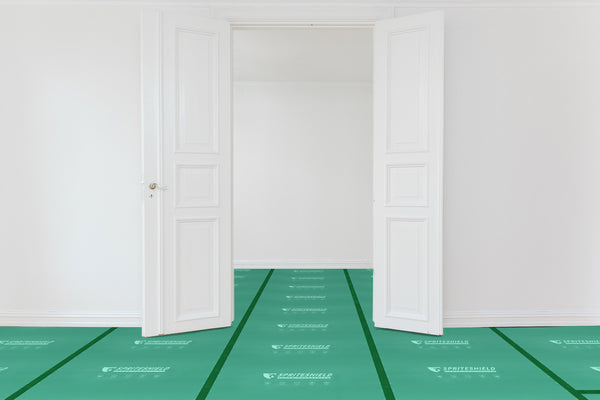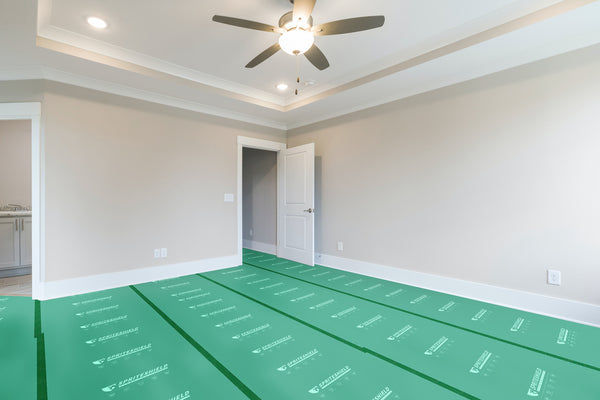When undertaking construction or renovation projects, protecting your floors from potential damage is crucial. Self-adhesive and non-adhesive floor protection materials both serve this purpose but have key differences that make each better suited for certain situations. Examining the pros and cons of self-adhesive versus non-adhesive options for different flooring types will help determine the best solution for your specific needs.
| Floor Protection Type | Self-Adhesive | Non-Adhesive |
|---|---|---|
| Pros |
|
|
| Cons |
|
|
Floor Protection Performance by Flooring Material
When choosing floor protectors, it's important to consider the type of flooring you have. Different materials will react differently to self-adhesive or non-adhesive protectors. Here's a breakdown of common flooring types and how they perform with these protectors.
1. Hardwood Floors
Hardwood is a popular choice for many homeowners due to its aesthetic appeal and durability. However, hardwood can be susceptible to scratches and dents from furniture.
- Self-adhesive protectors: They are often suitable for hardwood floors as they stay in place and provide good protection. However, over time, the adhesive may leave a residue that could damage the finish. Not worth the risk!
- Non-adhesive protectors: These are really the way to go for hardwood. They just slide right onto furniture legs and stay put without any adhesive. This prevents any chance of residue messing up your floors.
Read to know more about hardwood floor protection: How To Protect Hardwood Floors With These 12 Easy Maintenance Tips.
2. Tile Floors
The tile is durable and water-resistant, making it ideal for bathrooms and kitchens.
- Self-adhesive protectors: Tiles are so durable that sticky pads aren't likely to harm them at all. The adhesive won't damage or discolor ceramic, porcelain, or natural stone tiles. Just be aware the pads may be hard to remove later.
- Non-adhesive protectors: These will work great on tile too, provided they fit tightly. Choose cushioned, non-slip bottoms to avoid scratches from sliding around.
3. Laminate Floors
Laminate is a less expensive alternative to hardwood but can still get scratched or damaged.
- Self-adhesive protectors: It is advisable to steer clear of these on laminate because the adhesive could seep through seams over time and damage the protective top layer.
- Non-adhesive protectors: Look for soft, non-slip pads sized correctly for your furniture. They won't leave residue and will distribute weight to prevent dents.
4. Carpeted Floors
Carpet provides a soft, warm surface underfoot, but heavy furniture can leave indentations.
- Self-adhesive protectors: Don't bother with sticky pads on the carpet. They likely won't stick well to fibers and could leave a gluey mess.
- Non-adhesive protectors: Non-adhesive, preferably spiked or cupped protectors, are more suitable. They distribute weight evenly and prevent furniture from sinking into the carpet.
5. Vinyl Floors
Vinyl floors are water-resistant and easy to maintain, but they can be susceptible to scratches and dents.
- Self-adhesive protectors: These may work for a while, but the adhesive could react with vinyl and discolor it over time. You're better off playing it safe.
- Non-adhesive protectors: Your best bet is soft pads with non-slip bottoms sized correctly for furniture legs. They'll provide scratch protection without any residue risks.
Before implementing any floor protectors, it's always a good idea to test them on an inconspicuous area first to ensure they won't damage your specific flooring type.
If you would like to know more about the above materials, click here: 16 Temporary Flooring Options That Won't Ruin Your Floors.

Pros of Self-Adhesive Floor Protection
Self-adhesive floor protection offers noteworthy benefits that make it a convenient, customizable solution in many situations. Key advantages include:
- Easy Application: Self-adhesive floor protection films can be easily spread over ground surfaces like wood or marble. They conform to all areas, including stairs, corners, frames, and trim, with no tape required for application.
- Reusability: After use, the protective films can be cleaned, folded up, and stored to be reused repeatedly. This saves on costs compared to single-use flooring materials.
- Everyday Work Suitability: The films provide a protective coating that is paint and liquid-proof. They contain spills and messes on the surface for easy cleanup. Films protect floors from damage during everyday work.
- Surface Versatility: Films create an anti-slip barrier suitable for all flooring types, from soft carpets to hardwoods and tile. They enable a secure walking surface and prevent accidents.
- Customizable Fit: Films can be trimmed on-site to fit the exact dimensions of the space. Their adhesion allows them to conform smoothly to any area.
- Heavy Traffic Durability: Various thicknesses are available to withstand high foot traffic and potential scrapes from furniture or tools. Films resist punctures during use.
Cons of Self-Adhesive Floor Protection
While the simplicity of self-adhesive floor protection is appealing, there are some potential drawbacks to consider as well. These include:
- Lifting Finishes: Adhesive can pull up carpet fibers, varnish, tiles, and delicate surfaces.
- Short-Term Use: Adhesive wears out over weeks to months. Not suitable for long-term protection.
- Temperature Sensitivity: May not adhere as well in cold conditions. It can become gummy and harder to remove in heat.
- Residue: This can leave a sticky residue that requires solvents to remove entirely.
- Cost: More expensive per square foot than non-adhesive alternatives.
To summarize, self-adhesive films require careful product selection and application to avoid adhesive residue issues or damage, especially with long-term use.

Pros of Non-Adhesive Floor Protection
For certain surfaces and projects, non-adhesive floor protection has distinct advantages over adhesive alternatives. Some of these include:
- Won't Lift Finishes: Non-adhesive materials avoid bonding strongly to delicate flooring surfaces and finishes. When removed, they do not risk pulling up polyurethane, tiles, carpet fibers, or other existing layers the way adhesive products can. This prevents damage.
- Indefinite Use: Since non-adhesive materials do not rely on adhesive grip, they can safely remain in place, protecting floors for as long as needed without weakening over time. Projects that require long-term floor coverage benefit from this longevity.
- Temperature Resistant: Changing temperatures do not impact non-adhesive papers, foams, or films. Heat and cold leave them unaffected and securely in place. They won't become loose or slide around as some adhesive products can.
- Affordability: Without integrated adhesive costs, non-adhesive floor protection is generally less expensive per square foot compared to adhesive alternatives. This makes it a budget-friendly solution. Click to learn more about affordable ways: What is The Cheapest Way To Cover Your Floor?
- Recyclable: Many non-adhesive options like paper and cardboard are biodegradable and recyclable. This makes them an eco-friendly choice over plastic adhesive films, which can linger in landfills.
- Air Circulation: The non-adhesive materials do not form an airtight seal against the floor. This allows airflow, which enables any spills, condensation, or cleaning moisture to evaporate rather than getting trapped against the flooring.
In short, non-adhesive covers offer indefinite protection for delicate floors without adhesive risks. Their breathability and eco-friendly build make them suitable for many situations.
Cons of Non-Adhesive Floor Protection
Non-adhesive methods of protecting floors come with a few disadvantages to weigh against their benefits. Some potential issues are:
- Labor Intensive: Requires taping or weighting down edges, which is time-consuming.
- Taping Residue: Tape adhesive may leave a sticky residue that needs cleaning.
- Slippage: Can shift out of place without thorough taping or weights.
While non-adhesive materials avoid adhesive risks, they require more labor to install and maintain.
Key Considerations When Deciding
Various factors should guide the decision between self-adhesive and non-adhesive floor protection methods. Aspects to evaluate include:
- Duration: If long-term protection is needed, non-adhesive may be better. For short-term use, the adhesive is fine.
- Floor Type: Certain options are better suited to carpet, tile, wood, concrete, etc. Match the material to the surface. Read for more details: Types of Floors and Methods of Construction of Floors.
- Convenience: Self-adhesive saves installation time and labor. Non-adhesive requires more hands-on work.
- Budget: Adhesive films cost more per square foot compared to non-adhesive papers or mats.
- Eco-Impact: Non-adhesive paper and cardboard are more environmentally friendly and recyclable.
- Testing First: Always test products in an inconspicuous area first to check for any potential damage or issues.
To determine the best solution, carefully examine the unique needs of the project and the characteristics of the flooring. Testing products first provides further assurance an optimal choice is made.
Choosing the Right Thickness and Material
The thickness and material composition of floor protection products are other important factors to consider:
- Thicker materials like 1/8" foams and films stand up better to heavy foot traffic and dropped tools/materials. Thinner covers like paper are easily punctured. Click to know more about our products with different thickness: Temporary Floor Protection: How to Choose the Type in Spriteshield?
- Soft materials like felt and foam cushion impacts. Hard plastic films provide a smoother surface but less shock absorption.
- Low-density polyethylene and vinyl films offer maximum tear resistance. Paper and cardboard rip more easily under strain.
- Fire-retardant and anti-static materials are safer for welding, soldering, and similar hot work. Basic covers can be fire hazards.
- Reinforced films and grids help distribute weight and prevent indentation damage to softer flooring underneath.
- Materials with reinforced lamination technology, like those from Spriteshield, create a flatter and firmer protective surface that is slip-resistant and highly durable.
- Breathable materials are better for spill resistance and preventing moisture buildup. For example, the floor protectors from Spriteshield feature breathable construction suitable for indoor and outdoor use.
- All-around protection against scratches, spills, paint, mud, dust, and debris is also key. Some temporary floor covers offer full protective coverage for hardwood, tile, concrete, and most flooring types.
- Reusability and customization add further value. The biodegradable floor protection can be reused and even customized for a perfect fit. Read to know more about biodegradable floor protection: Eco-Friendly Flooring.

Conclusion
In summary, self-adhesive and non-adhesive floor protection materials both have merits along with some disadvantages. Non-adhesive options tend to be a better choice for long-term use, delicate surfaces, breathability, and eco-friendliness. Self-adhesive films excel at convenience, customization, and keeping out moisture. Consider the unique needs of each project and test first when uncertain. With smart product selection and proper prep work, both adhesive and non-adhesive floor protection can safeguard surfaces during construction and renovations.
Leave a comment
All comments are moderated before being published.
This site is protected by hCaptcha and the hCaptcha Privacy Policy and Terms of Service apply.